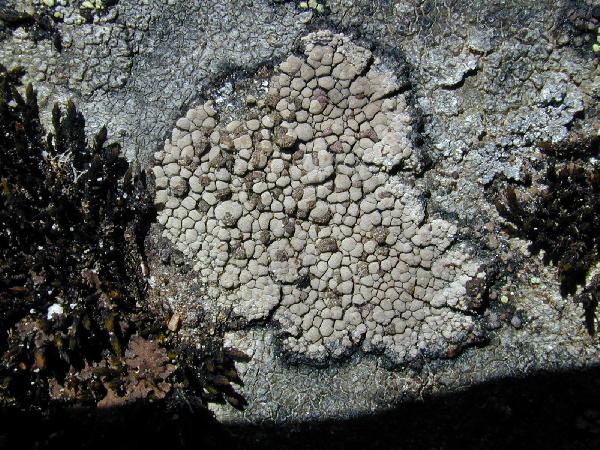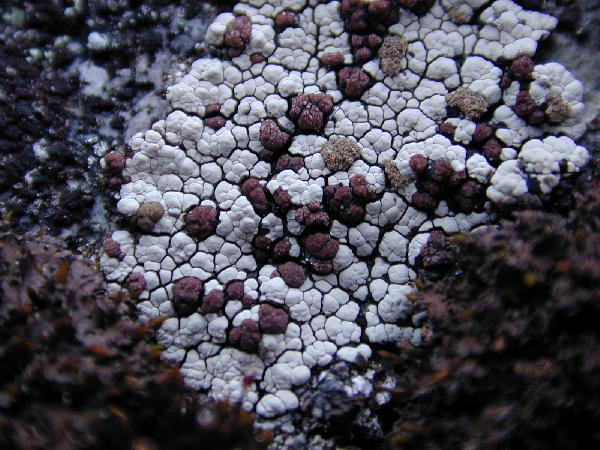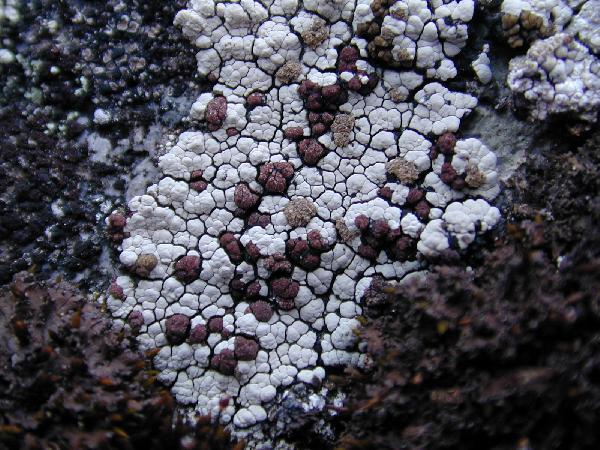Amygdalaria panaeola (Ach.) Hertel & Brodo
in Brodo & Hertel, Herzogia, 7: 510, 1987. Basionym: Lecidea panaeola Ach. - K. Vetensk.-Akad. Nya Handl.: 267, 1808.
Synonyms: Huilia panaeola (Ach.) Hertel; Lecidea panaeola var. vulgaris Th. Fr.; Psora panaeola (Ach.) Anzi
Distribution: N - TAA (Nascimbene & al. 2022), Lomb, Piem (Isocrono & al. 2004), VA (Piervittori & Isocrono 1999).
Description: Thallus crustose, episubstratic, up to 2 mm thick, pinkish grey, pale brown or yellowish pink, areolate-verrucose, often sorediate, usually delimited by a dark prothallus. Areoles up to 1.2 mm wide, convex, sometimes bullate, rounded to angular by mutual compression (especially in the central parts of thallus), often sorediate along the margins. Cephalodia arising mainly between the areoles, pinkish or reddish brown, 0.5-1.4 mm wide, with a tuberculate-botryoid surface. Medulla white, I-. Apothecia rare, arising between the areoles and usually not protruding, lecideine, up to 1 mm across, with a mostly flat, black, epruinose, roughened disc and a thin, brownish black, persistent or finally excluded proper margin. Proper exciple poorly developed, brown, of conglutinated, radially arranged hyphae; epithecium brownish black, covered in a granular, black layer; hymenium colourless, up to 160 μm high, I+ blue; paraphyses coherent, slender, branched and anastomosing, not or only slightly thickened at tips, often moniliform in upper part; hypothecium dark brown. Asci 8-spored, elongate-clavate, with a thin, outer amyloid layer and a thickened tholus penetrated by a pore, the sides of which stain I/KI+ deep blue, Porpidia-type. Ascospores 1-celled, hyaline, ellipsoid, 22-27 x 9-15 μm, when young with a thin perispore. Pycnidia black, immersed. Conidia short-acicular, straight, 7-10 μm long. Photobiont chlorococcoid; cephalodia with Stigonema. Spot tests: cortex K-, C+ red, KC+ red, P-; medulla K-, C-, KC-, P-. Chemistry: cortex with gyrophoric acid and traces of lecanoric acid.
Note: an arctic-alpine to boreal-montane, incompletely circumpolar species of weathered, mineral-rich siliceous rocks close to the ground, in areas with late snow-lie.
Growth form: Crustose
Substrata: rocks
Photobiont: green algae other than Trentepohlia (primary); cyanobacteria, filamentous (e.g. Nostoc, Scytonema) (secundary, e.g. in cephalodia)
Reproductive strategy: mainly asexual, by soredia, or soredia-like structures (e.g. blastidia)
Commonnes-rarity: (info)
Alpine belt: very rare
Subalpine belt: extremely rare
Oromediterranean belt: absent
Montane belt: extremely rare
Submediterranean belt: absent
Padanian area: absent
Humid submediterranean belt: absent
Humid mediterranean belt: absent
Dry mediterranean belt: absent

Predictive model
Growth form: Crustose
Substrata: rocks
Photobiont: green algae other than Trentepohlia (primary); cyanobacteria, filamentous (e.g. Nostoc, Scytonema) (secundary, e.g. in cephalodia)
Reproductive strategy: mainly asexual, by soredia, or soredia-like structures (e.g. blastidia)
Commonnes-rarity: (info)
Alpine belt: very rare
Subalpine belt: extremely rare
Oromediterranean belt: absent
Montane belt: extremely rare
Submediterranean belt: absent
Padanian area: absent
Humid submediterranean belt: absent
Humid mediterranean belt: absent
Dry mediterranean belt: absent

Predictive model
 INDEX FUNGORUM
INDEX FUNGORUM
 GBIF
GBIF
 DOLICHENS
DOLICHENS














